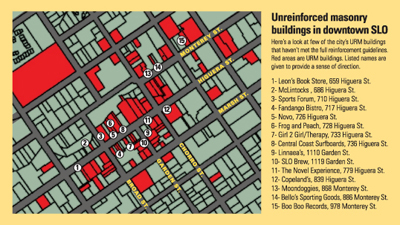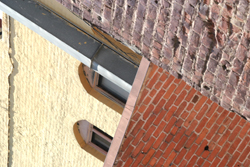Forever
changed
Over the next eight years, SLO's downtown will endure construction
dust, disappearing businesses, and escalating rents - all for the sake
of seismic safety
BY ABRAHAM HYATT
PHOTO BY CHRISTOPHER GARDNER
Whether it realized it or not, San Luis Obispo began to rewrite its history on Dec. 22, 2003.
It took until Aug. 13 of this year for the regulatory aftershocks of that deadly Central Coast earthquake to reach San Luis Obispo's City Council, but when they did, every council member present approved that new future.
And their new ordinance sounds simple enough:
By 2012, the city's 100 unreinforced masonry buildings - 76 of them in the downtown area - will all yield to the contractor's hammer. Roofs will be anchored to walls. Walls will be anchored to floors. Steel frames will strengthen everything. In all, the work will require the dislocation, disruption, or maybe even permanent closure of almost 50 percent of downtown San Luis Obispo's businesses.
But as a result of that work, the city is optimistic it won't suffer the same fate that Paso Robles did.
Tom Baach, the city's building official, was the star of the show at the early August meeting when the City Council approved its unreinforced masonry ordinance. He outlined details and explained issues with the help of some bulleted, text-filled slides.
Halfway through his presentation, photos of that gray December day filled the large screen in the City Council's chambers. There were the buried cars, the collapsed roof, the mounds of shattered bricks - the remains of Paso Robles' Acorn building.
Baach raised his hand at the screen.
"I would point out that the part of the roof you see there, resting on that vehicle, was supported by an unreinforced masonry wall," he said.
"It's likely that if the roof had been properly anchored to the top of that wall, the building would not have collapsed and would have allowed a better opportunity for those occupants to escape."
 |
What will change and when
While it sounds like architectural jargon, unreinforced masonry, or URM, is easy to describe: it's brick that's been cemented together with lime or lime-sand mortar.
A century ago, that was a common building practice. Today, construction workers use stronger cements along with steel reinforcing rods to ensure a brick building's safety during an earthquake.
In 1990, San Luis Obispo city officials started talking about how to upgrade those old brick buildings. It took a lot of controversial discussion, but in 1997 the City Council ruled that by 2017 all URM buildings had to be retrofitted or destroyed. According to the plan it laid out at the time, 50 percent of the seismically unsafe buildings should have been upgraded by 2002.
As of 2004, only 30 percent had reached that point.
Inspired by that fact and December's unsetting events, San Luis Obispo Mayor Dave Romero used this year's first City Council meeting to reactivate the city's seismic task force.
For the next eight months, city officials, Council Member John Ewan, members of the San Luis Obispo Chamber of Commerce, various seismic and geology experts, and Romero discussed how to speed up the retrofit process.
They reviewed technical data about earthquake faults. They surveyed URM building owners to find out how soon they could strengthen their properties. They tried to find ways for the city to help offset the costs.
According to Patricia Wilmore, the director of governmental affairs at the Chamber of Commerce and a member of the task force, they even listened to testimony from experts who offered "wildly varying" - as she put it - predictions as to when the next quake would hit the city.
And then the two sides - the city and the representatives of the building and business owners - bargained.
Originally, the city wanted everything done by 2010. The Chamber countered that they wanted a plan that gave businesses as much flexibility as possible. After a long and sometimes fevered negotiating process, both sides agreed on a two-part, two-deadline plan.
In it, if a building has no retrofitting done by 2007, then it must be fully strengthened by 2010.
But if a building has reached what's called Level A by that 2007 deadline, then its owners can take until 2012 to reach what's called Level B.
Level A means that parapets have been removed or braced and the walls have been anchored to both the roof and floor. Level B means that a building's walls and front have been reinforced with steel frames.
Along with those deadlines, building owners must submit an application for a retrofit permit by July 1, 2005 and have those permits in hand by Jan. 1, 2006.
While the city played hardball when it came to dates, it was more than willing to help building owners as well.
Originally, officials wanted to provide grants for retrofitting but that plan was shot down when they discovered that by doing so, state law would require owners to pay a state-mandated wage for the rest of the retrofit - a cost that was considered prohibitive.
Instead, the city has lowered its permit fee to $40. It's also pitching in $12,000 for the state-mandated "This in an unreinforced masonry building" placards that owners must install at their front entrances, and it's offering a city building, 955 Morro St., as a temporary space for displaced businesses.
They're even hiring a "seismic coordinator" to act as a liaison between building and business owners and the city.
Mayor Romero called it a "carrot and stick" approach: "There's still folks that are going to be hurt. But as prudent stewards of the community, we simply had to pass something."
Romero wasn't the only one happy with the outcome of the task force and the subsequent ordinance. The night the mayor and the rest of the Council made their ruling, Chamber officials and business owners stood up and commended the city for its decision.
While accolades flowed that night, nobody had received a retrofit bill yet. Weeks later, city and Chamber of Commerce officials were unable to estimate a citywide retrofit price tag. In fact, none of the many businesses that New Times talked to for this story had arrived at a total estimate of what the strengthening would cost.
Building Official Baach did make one prediction in his report to the City Council: Each owner, he said, should plan on spending about $20 for every square foot of building.
Overlay that equation with a map of URM buildings in San Luis, and it quickly becomes clear that the total cost in construction and displaced or even lost businesses reaches the multimillion-dollar mark.
|
|
The tenants' perspective
Bring up the URM ordinance with the people who work at downtown businesses and it doesn't take long for them to tell their earthquake stories.
Steve Carson is the general manager of Central Coast Surfboards on Higuera Street.
"All I know is that on that December day when it was shaking; man, we were running for the exits. Our surfboards were swinging and the posts down the middle [of the building] were doing this weird wobble. Everyone had jets on," he said.
Next month, the owners of Central Coast Surfboards will sit down with their landlord and discuss the future. While their building is already at Level A, Carson said, they still plan on vacating when remodeling begins and will return, "even if rents double," when the work is done.
Like many other people involved in downtown businesses, Carson brought up several fears that, despite the city's proactive work with owners, still exist.
His main concern was how disruptive the construction would be. As an example, he pointed to the remodel work currently underway on Chorro Street and how's that's affected the stores and restaurants that surround the site.
Tom Bello, owner of Bello's Sporting Goods and the Monterey Street building it sits in, had his own set of fears.
Bello, like many other owners, is facing the decision of whether to retrofit or demolish and rebuild. When interviewed, he had not made plans for either but was worried about the number of available contractors when he does move forward.
"The only thing that's certain is that there's going to be a lot of changes," he said. "Not only in the buildings, but in the businesses. Hopefully it'll work out and San Luis can remain somewhat similar to what it is now."
Jim Hill, owner of The Novel Experience on Higuera, was equally pragmatic if not a little more pessimistic.
For the past 15 years that he's been in business, his landlord has been warning him that he would someday retrofit. But the landlord wrote a generous clause into the bookstore owner's lease - Hill has the first option to return to the space with no rent increase when repairs are done.
Still, he has no idea when that will be. And, "Whether we're able to survive the interruption is doubtful." He might relocate for the duration of the construction, he might simply pack everything up and take a long vacation, "And the third is just to call it quits," he said.
He even presupposed that more than half of downtown's small businesses would follow suit.
"Hopefully the other half of the marginal locals are so stubborn and stupid that they'll stick around and try it again after the work is done," he said.
The future of downtown SLO
Richard Wiegers is one of the few downtown business owners that owns his own building. But, unlike many of them, he thinks he'll be able to remodel his business, Leon's Book Store, without having to close his doors even temporarily.
"I'm more pragmatic than concerned about it," he said. "Either it happens while [Leon's] is open or the store goes away and it becomes another downtown discount clothing store. That's the choice."
That's a feeling that other owners reiterated when asked about how the mandatory construction would change the downtown area. Many feel the massive seismic retrofit is simply part of the shift that, for better or worse, the city's center has gone through over the last few years.
Rob Rossi, who owns seven buildings in San Luis Obispo that need seismic work, agreed with Novel Experience owner Hill in that many downtown tenants will not come back to their original buildings. For most, he said, it's highly impractical to move everything to a temporary location and then come back a few months later.
But even knowing that, Rossi was still optimistic, and he turned almost philosophical as he tried to explain how downtown's "specialness" would also be what ensures its future.
"I think downtown is a sense of community," he said. "Everybody knows it and believes it and you see that we have it - cities from all over the state and country come to figure out how we got it - and so obviously it's here. Whether I can put it in words or not, it's all something we say is worth protecting."
Carson, over at Central Coast Surfboards, thinks it's that sense of community that will shape the future.
Or, as he put it: "Hold hands, guys, we're all jumping out of the plane together. Because we all really do live and die by the strength and mix of everybody around us."
Staff Writer Abraham Hyatt can be reached at [email protected].
